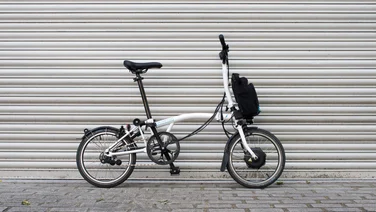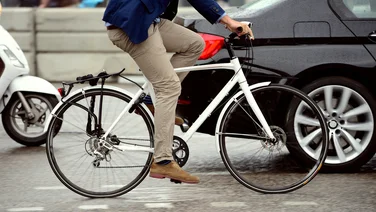To help us provide you with free impartial advice, we may earn a commission if you buy through links on our site. Learn more















- Great ride and comfort
- Clever security features
- Good range and power
- Very heavy
- Saddle is bulky
- Cadence sensing only
With e-bikes increasing in popularity, we’re seeing both the prices fall and the practicality rise rapidly. The Volt Metro encapsulates this progression neatly. Not only is it a great bike to ride, with good range and comfort but it also won’t break the bank. Indeed, it costs around half as much as the Brompton Electric.
READ NEXT: Our pick of the best exercise bikes start from just £93
Volt Metro review: What you need to know
Just like the Brompton Electric, the Volt Metro is a folding e-bike. It isn’t as light as the Brompton nor as neat and compact when folded away but it is a good option for those who have limited storage options for a bike at home or when they get to the office.
Despite the folding frame, the Volt Metro rides like a regular e-bike. It’s super comfortable and has a powerful 250W brushless motor built into the rear hub, which provides assistance as you pedal – up to a speed of 15.5mph (25km/h), as per UK laws. It’s available in two models: the regular version with 40 miles of range and the XL, which comes with a bigger battery and up to 60 miles of range.
I was sent the model with the smaller battery (40-mile range) but whichever you choose, the Volt Metro comes fitted with all the features the cyclist with a longer commute could possibly need. It has front suspension forks, built-in lights, plus an integrated lock, luggage rack and kickstand all included as standard.
Volt Metro review: Price and competition
Considering how well equipped it is, at £1,399 for the regular model and £1,599 for the increased range model, the Volt represents exceptional value for money.















The class-leading Brompton Electric is twice the price of the Metro at £2,595 and although it folds up much smaller and is far lighter, it’s more bare-bones in terms of its feature set. We loved the GoCycle GX, too, for its comfort, the quality of its ride and its high-tech approach but it too is painfully pricey at £2,899.
If you’re looking to save money on your e-bike, the strongest competition for the Volt Metro comes from the cheap Decathlon B’Twin Tilt 500. Again, this is much more basic than the Volt but costs half as much, at an almost inconceivable £650.
Volt Metro review: Design and features
Why would you choose the Volt over the B’Twin, then given the difference in price? There are quite a few reasons and most of those concern features. First and foremost is that the Volt is the more comfortable bike to ride.
It has SR Suntour suspension forks up front and a Zoom suspension seatpost, to take the edge off most of the lumps and bumps you’ll come across on the less-than-perfect roads you find in most cities. There’s a big, plush, comfy-looking Velo Plus saddle, too, although it’s not to my taste. Plus, the bike comes with a pair of smooth-rolling, puncture-resistant Schwalbe Big Apple tyres.















The Volt is also much more comprehensively fitted out than the Brompton Electric and the B’Twin. It has a big 36V 400Wh (or 630Wh) battery, which delivers a claimed 40 miles (or 60 miles) of range and charges in three to four hours. Conveniently, the battery can be quickly removed from its bay just behind the seat tube if you can’t position your bike near a power socket – just unlock it and slide it up and out. It’s worth noting, though, that you might have to raise the saddle to do this if you have it set quite low.
Another advantage the Volt Metro holds over the B’Twin is that it has a bike computer mounted on the handlebars, which shows your current speed and assist levels, battery capacity and trip distance. There’s no Bluetooth connectivity, so you can’t make changes via the screen of your smartphone but the Volt’s computer does have one neat trick up its sleeve: it doubles as a security device.
If, heaven forbid, someone steals your bike, they won’t be able to fire up the motor without touching the supplied keyfob to the screen of the computer. The Metro also comes with an Abus wheel lock fitted to the rear wheel, making it an even less attractive proposition for thieves.
When you consider it has Shimano M375 cable disc brakes, a solidly-built luggage rack with handy integrated bungees, a kickstand, integrated LED lights that run off the battery and a six-speed Shimano Acera drivetrain, there’s precious little you’ll need to add.















The downside of all these features is that the Volt Metro is heavy. And when I say heavy, I really mean it. If you think you’re going to be lifting this in and out of your car boot or running up and down steps and slinging it on and off trains without a second thought, think again. The bike itself, without a battery installed, tips the scales at a back-breaking 18.5kg. Add the 3.2kg battery and that rises to a shoulder-dislocation-waiting-to-happen 21.7kg. Compared with this, the Brompton Electric at 13.6kg (16.6kg with battery) looks like a featherweight.
It’s so heavy that folding it turns out to be primarily an exercise in reducing bulk for storage in the back of a motor home or under the stairs at home, for instance. Bringing it on trains simply won’t be a practical option for most people.
This is a bit of a shame because the folding mechanism works effectively and simply. You split the frame by undoing a clamp, lifting and folding the whole thing in half, then undo a clamp in the centre of the steering tube, which folds down flat against the front wheel. Secure the whole lot with the bungee cords attached to the rack and you’re done.
Volt Metro (2019) review: How does it ride?
It may be a bit of a lump, then, but out on the road the Volt Metro is a dream to ride. Saddle aside, I found it supremely comfortable for the majority of my 10.1-mile commute from north-east London to the centre and out again. The suspension at the front and under the seat proved effective, the Shimano gears shifted smoothly and predictably and the cable disc brakes proved reliable stoppers, too. Having said that, I would have preferred something a little stiffer and more sturdy feeling than the rather mushy Tektro brake levers.















The 250W motor is decent, too. It uses cadence sensing at the crank to figure out when and how much assistance to supply, plus you can select from five different power levels via the handlebar-mounted computer. At maximum power, the motor gives a hefty surge of power – more than all the folding e-bikes I’ve ridden recently – and the bike accelerates smoothly and strongly until its 15.5mph limit is reached. In fact, in some instances, I felt the acceleration was too much in this mode and for tight, slow-speed manoeuvres I found myself switching down a level or two before changing back up when I wanted to go full steam ahead.
Another issue, and a side-effect of the fact that the Volt uses cadence rather than torque sensing, is that there doesn’t feel like there’s much of a connection between pedalling input and the amount of power delivered by the motor. Select the highest level of power assist and you can turn the pedals without putting any kind of effort in.
I prefer the way a torque-sensing system feels to ride; e-bikes with a torque sensor feel much more like a normal bike to ride, only feeding in power from the motor when pressure is applied to the pedals. There is something to be said for how easy and comfortable the Volt Metro makes riding when you don’t feel like putting in the hard yards, however. It even makes light work of moderate hills.
Volt Metro (2019) review: Verdict
Overall, despite the odd reservation here and there, the Volt Metro represents great value for money. It rides well, gives you plenty of oomph when you need it and there’s loads of equipment included as standard.















It’s true that the Metro can’t match the B’Twin Tilt 500 on price but, then, nothing else can. And it’s such a different proposition in terms of the level of equipment supplied, the range and the ride quality it delivers that such a comparison isn’t strictly fair anyway.
It’s also a fact that the Volt Metro isn’t a bike you’ll want to be carrying around or lugging up and down the stairs and on and off trains. However, if you’re looking for an e-bike to take the strain out of a moderately long commute and a space-saving folding design so it can squeeze into a small space when you get to the office and back home, it’s a first-class choice.






